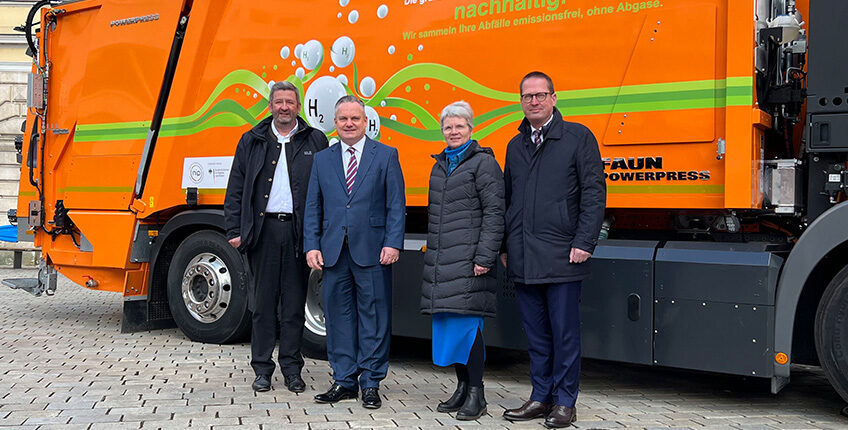Municipal services test new technology in daily operation.
The first of two waste vehicles with hydrogen fuel cells has arrived at Ingolstädter Kommunalbetriebe (Ingolstadt municipal services) and has immediately begun service. Lord Mayor Christian Scharpf, Mayor and Chairperson of the Board of the Ingolstädter Kommunalbetriebe (INKB) Dorothea Deneke-Stoll, Economic Officer Georg Rosenfeld and Thomas Schwaiger, INKB board member, together presented the vehicle on 28 March on the town square.
The new fuel cell waste vehicle will be used to collect waste in the immediate urban area. The municipal services have calculated that the use of the hydrogen waste vehicle yields a savings potential of around 17,500 litres of diesel compared to a conventional waste vehicle, thereby reducing CO2 emissions by approx. 46,345 kilogrammes per year, per vehicle.
“We are proud to contribute to launching an innovative and climate-friendly technology for Ingolstadt and Germany”, said Thomas Schwaiger, member of the INKB management board. “We will now test the waste vehicle in daily operation with regard to reliability, costs and environmental benefits and we’re particularly looking forward to employee feedback.”, continued Schwaiger. Ingolstädter Kommunalbetriebe have made arrangements to somewhat alleviate the challenges faced by users of a new technology in their workday. Both the drivers and waste collectors received individual training for the waste vehicle. The charging infrastructure was organized in Ingolstadt. The structural conditions on site, both in the garage as well as in the workshop, are yet to be adapted.
The waste vehicle has an electric drive with a 110 kilowatt-hour battery, which is supplemented by a hydrogen fuel cell with a maximum capacity of 30 kilowatts. It can be refuelled with 16 kilogrammes of hydrogen. In addition, the vehicle recovers energy when the accelerator pedal is not utilized. This so-called recuperation ensures that the mechanical brake is only required for emergency braking. This results in the production of less fine particulate matter overall.
The vehicle has an electric drive capacity of 240 kilowatts and a torque of 4,000 newton metres. The maximum payload amounts to 9 tonnes in total. The driver’s cab can be accessed through a low entrance, similar to a bus. The waste vehicle can also be operated with an throttle pedal, which will in particular, simplify operation in daily service. Advantages and disadvantages for the driver and the waste collectors in their daily work will be collected in the test phase that begins now.
The waste vehicle with fuel cell technology is the first of two waste vehicles that the municipal company will use in future. Furthermore, a sweeper with this technology has been ordered to test its use in street cleaning. All three purchases are supported under the National Innovation Programme for Hydrogen and Fuel Cell Technology with over two million euros by the Federal Ministry for Digital and Transport. This funds around 90 per cent of the additional costs compared to conventional vehicles. The funding guideline is coordinated by NOW GmbH and implemented by Project Management Jülich (PtJ).
The municipal services are partners of the project: ‘IN2H2 – Hydrogen concept Ingolstadt’. The IN2H2 concept proposal, which received an award by the Federal Ministry for Digital and Transport, aims to conduct a detailed investigation into the technical and economic feasibility of introducing hydrogen mobility to the municipal vehicle fleets in conjunction with local hydrogen production.
Source: Ingolstädter Kommunalbetriebe (INKB)
Image source: INKB


